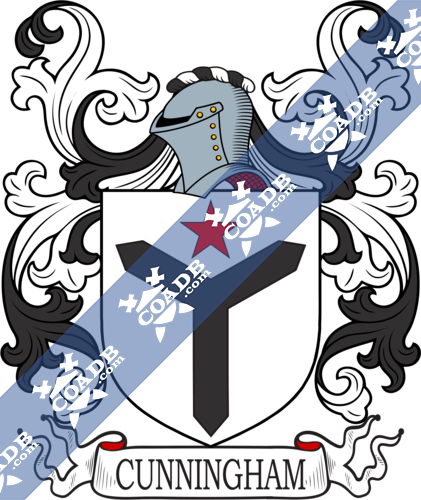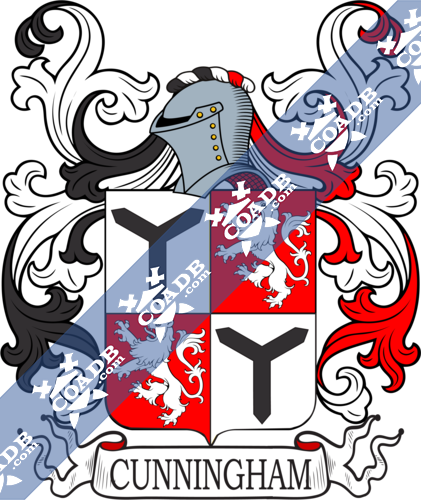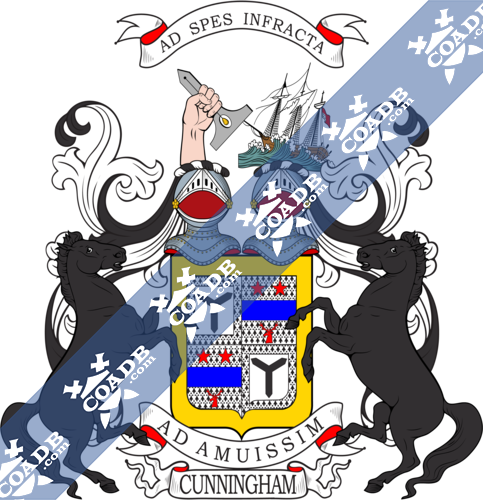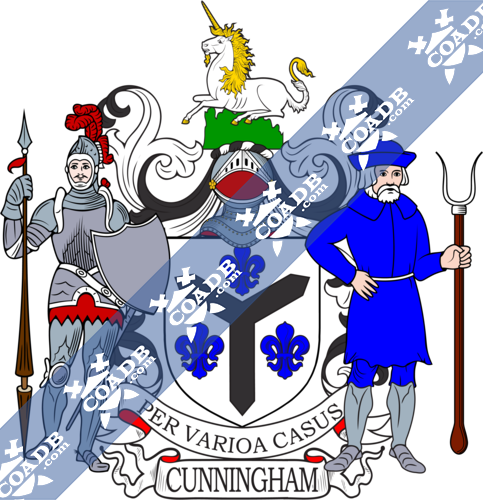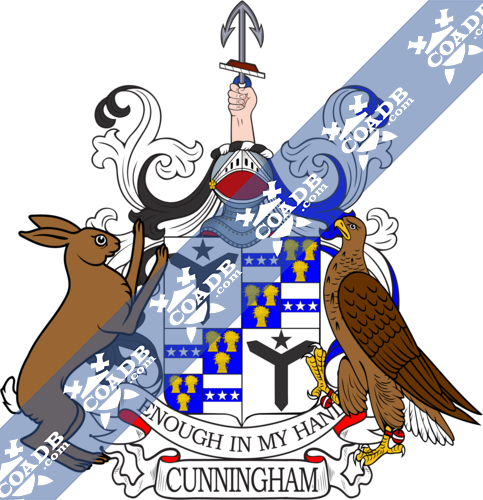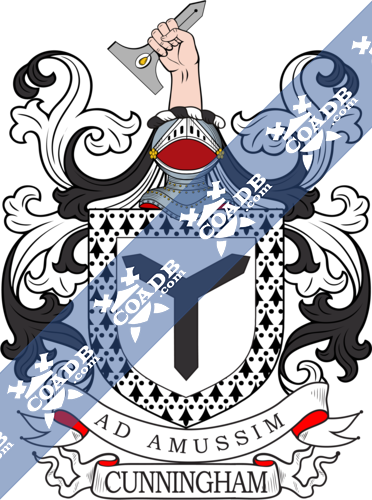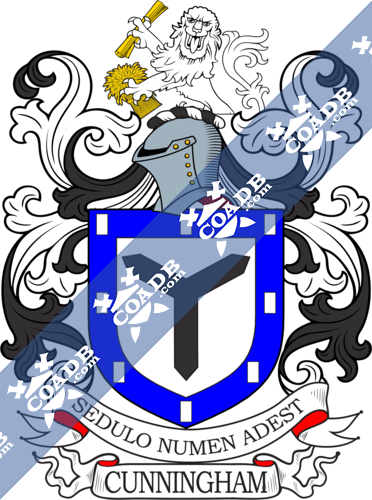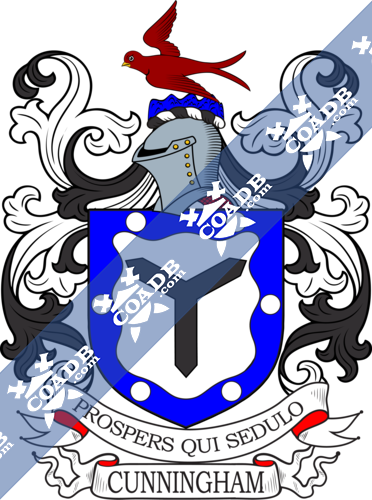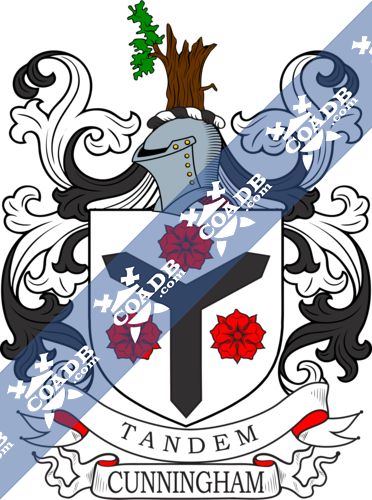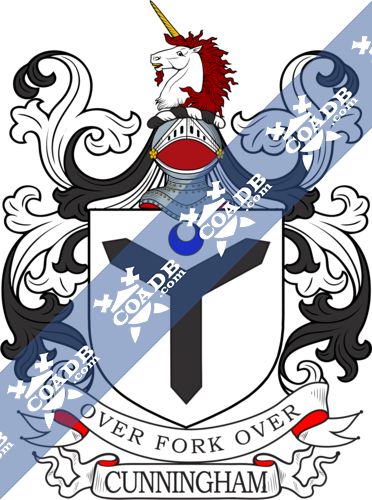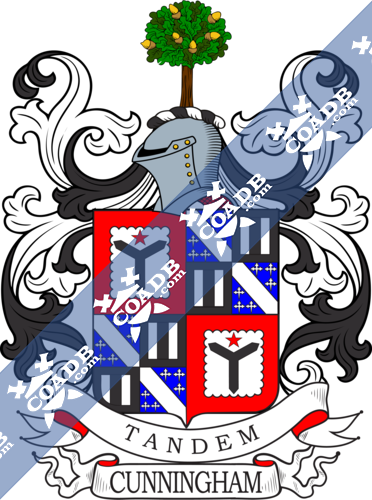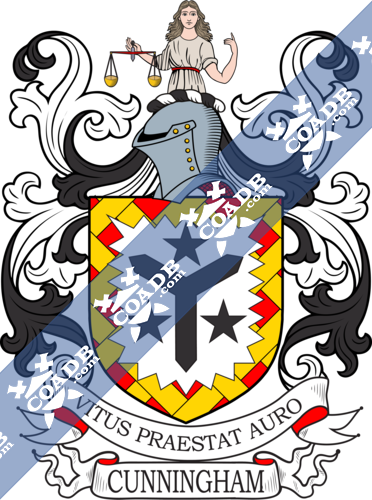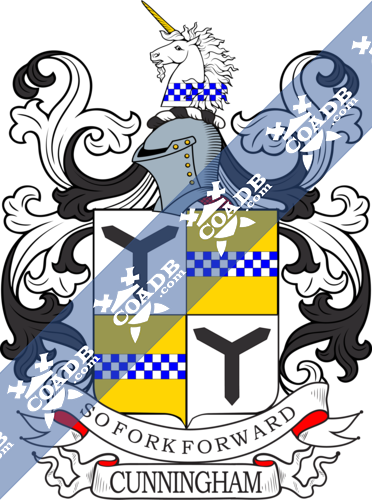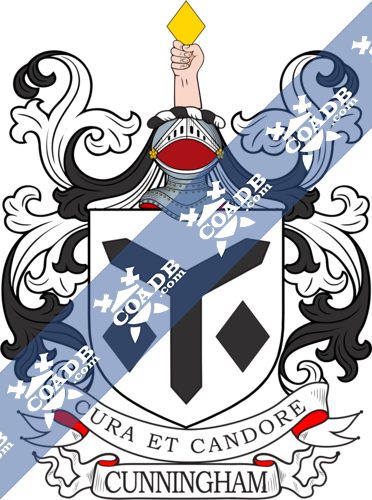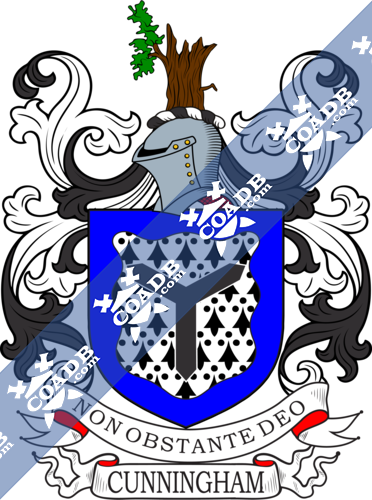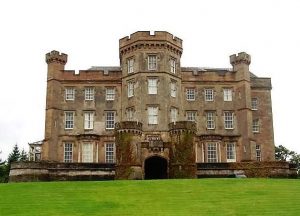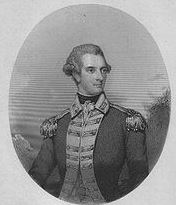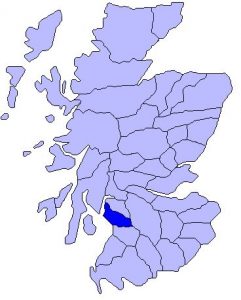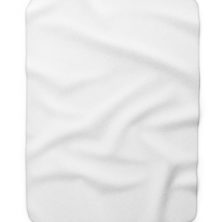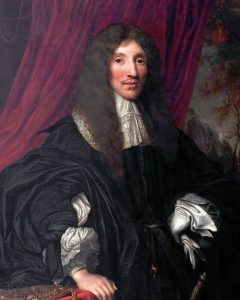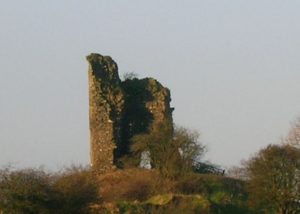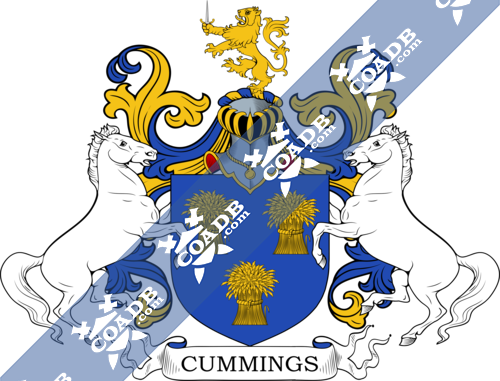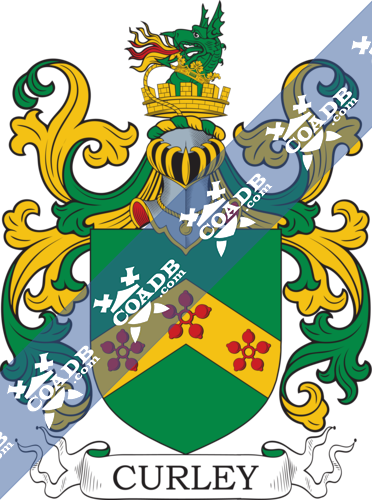Cunningham Family Crest, Coat of Arms and Name History
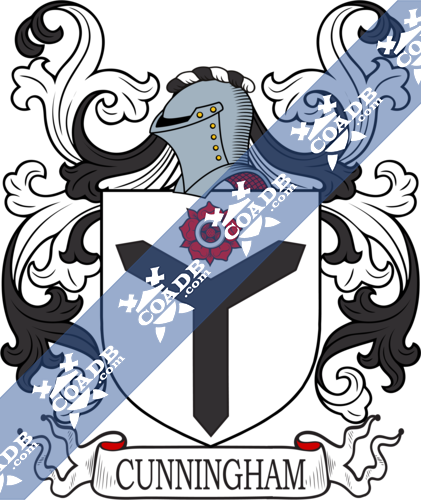
Cunningham Coat of Arms Gallery
Don’t know which Coat of Arms is yours?
We can do a genealogical research. Find out the exact history of your family!
Learn MoreCunningham Surname Name Meaning, Origin, History, & Etymology
This is a locational or habitational surname meaning “of Cuningham”, denoting a person who lived in or came from the district of Cuningham in North Ayrshire, Scotland. In his 1857 book Surnames, Bernard Homer Dixon states the name may derive from the word to church butter. Another author, Henry Harrison, states it refers to a dweller at a Royal Manor (deriving from the Old English word cyning, meaning royal, and ham, meaning home or manor. Yet another, William Arthur, states the name signifies the dwelling of the king or chief, deriving from the Saxon word cyning or the Dutch and German koning, meaning a leader or king. The name was recorded in 1153 AD in the form Cunegan, a Celtic name of uncertain origin. In Ireland, it was a surname adopted by Scots, a derivation of the Gaelic name O’Cuinneagain, meaning descendant of Cuinneagan, an old personal (first name), from a double diminutive (shortened version) of the Old Irish masculine given name Con,, meaning leader or chief. One source asserts the earliest known ancestor of this family was a man named Wernebald who came to Scotland from northern England in the 1100s AD and was a vassal of Lord High Constable of Scotland, the Norman Hugh de Morville, from whom he obtained the manor of Cunningham. However, if one uses wikitree.com, one can find he was the grandson of Quhen de Cunningham who was born around 975 AD in England. The website ElectricScotland.com states the following regarding the origin of the family coat of arms: “The statement of Van Bassen, a Norwegian genealogist, that one Malcolm, the son of Friskin, obtained the thanedom of Cunningham, for assisting Malcolm Canmore when prince of Scotland, in escaping from Macbeth, by forking hay over him in a barn in which he had taken shelter, and that his posterity, from that circumstance, adopted Cunningham as a surname and a shakefork for their arms”. One source asserts this family descendants from the Dalriadans, an ancient Scottish tribe, and originally lived on the western coast of Scotland, as well as the Hebrides Islands.
Spelling Variations
Some spelling variants or names with similar etymologies include Cunninghame, Cuningham, Cuninghame, Cunyngham, Cunnigham, Cunningam, Cunninghamm, Conningham, Conaghan, and several others.
Popularity & Geographic Distribution
The last name Cunningham ranks 198th in popularity in the United Status as of the 2000 Census. The name ranks particularly high in the following four states: West Virginia, Ohio, Tennessee, and Missouri. The surname Cunningham frequency/commonness ranks as follows in the British Isles: England (237th), Scotland (79th), Wales (399th), Ireland (71st) and Northern Ireland (57th). In England, it ranks highest in county Cumberland. In Scotland, the surname ranks highest in counties East Lothian, Fife, and West Lothian. In Wales, it ranks highest in Cardiganshire. In Ireland, it ranks highest in county Roscommon. In Northern Ireland, it ranks highest in county Down. The name is also present throughout the remainder English speaking world: Canada (334th), New Zealand (187th), Australia (236th), and South Africa (989th).
Early Bearers of the Surname
A one Richard de Cunningham was documented in the Ancient Records of the Scots Peerage in 1210 AD. A one Thomas Conningham was buried at St. Michael, Cornhill, London in 1592. An early marriage involving this surname was Elizabeth Cunningham who married Robert Hammond in 1711.
Cunningham Family Tree & Cunningham Genealogy
The following is a discussion of seven different noble, royal, landed, or aristocratic families bearing this last name.
Cuninghame of Lainshaw
The lineage of this branch of the Cunningham family tree begins with William Cuninghame of Lainshaw, and Duchrae, who descended from a younger branch of the Cunninghames of Caprington, and who married Margaret Nicholson, daughter of Honorable George Cranstoun, son of James, 6th Lord Cranstoun and Jane Kett, and had seven issue with her as follows: John, Maria Edmonstoune Cranstoun (of Corehouse, Lanark), Anne Selby (married Richard Barre Dunning, 2nd Lord Ashburton), D’Arcy Maxwell, Louisa, and Isabella (married Roderick Macleod of Cadboll). His son and heir was John Cuninghame, Esq. of Lainshaw, in county Ayr, Scotland, who was a Justice of the Peace and Deputy Lieutenant born in 1796. In 1831, he married Eliza Mary, daughter of Captain Upton of the Royal Navy and fathered the following children with her: John William Herbert (Lainshaw), Richard Dunning Barre (of Duchrae, Justice of the Peace, Deputy Lieutenant, Captain of the 2nd Life Guards), George Wenceslaus, Charles Edward Harris Edmonstoune-Cranstoun (married Edith Mary ), Eliza Anne, and Margaret Mary. His son John William Herbert Cuninghame, Esquire of Lainshaw, county Ayr, was a Captain in the 2nd Life Guards who was born in 1834 and in 1867, married Emily, daughter of Major George Graham, youngest son of Sir James, and had two issue with her: Richard John (1871) and Emily (1872). The Cunuinghame Coat of Arms (erroneously called the Cuninghame Family Crest) is blazoned in heraldry as follows: Argent, a shakefork sable within a bordure ermine. Crest: A dexter hand holding a plumb-rule proper. Motto: Over, fork over.
Cuninghame of Craigends
The Cuninghame genealogy begins with Alexander, 1st Earl of Glencairn, who in 1477 AD, gave the lands of Craigends to his second son William. William married Elizabeth, daughter of Sir William Stewart of Arthurlie, with whom he had a son and heir named William. He later married Marion, daughter and co-heir of Sir John Auchinleck, and had a son with her named David (of Bartenholm, progenitor of the Cunninghames of Robertland). His son William Cuninghame of Craigends married Giles, daughter of Sir John Campbell of Loudon, with whom he had several daughters and three sons: Gabriel (his heir), William (ancestor of Cuninhame of Carncuren), Robert (ancestor of Cuninghame of Bedland). His son Gabriel married a daughter of the Livingston family of Kilsyth, and had issue with her as follows: Janet (married Sir Patrick Houstoun), another daughter (married Andrew Stirling of Portnallan and Law), William, and James (ancestor of Cuninghame of Achinyards). He died in 1547 at the Battle of Pinkie and was succeeded by his eldest son William. His son William married Margaret, daughter of William Cuninghame of Cunninghamehead, and he died in 1568, whereupon he was succeeded by his son, Alexander. This Alexander of Craigends married Lady Elizabeth Cuninghame, daughter of William, 6th Earl of Glencairn, and had a son and heir with her named William. This son was William Cuninghame of Craigends, who married Elizabeth, daughter of Archibald Stewart of Castlemilk, and had a daughter and son with her. The son was William, who married Elizabeth, daughter of Sir John Napier, Baronet of Merchistown, with whom he had three daughters and a son named Alexander. He died in 1636 and was succeeded by his grandson Alexander. This Alexander Cuninghame of Craigends married Janet, daughter of William Cuninghame of Achinyards, and had the following five children with her: William, Elizabeth (married George Houstoun of Johnston), Rebecca (married John Hamilton of Grange), Janet (married John Alexander of Blackhouse), and Marion (married Alexander Porerfield of Fulwood). His son Willaim was elected by the Freefolder of county Renfrew, Scotland (modern day Great Britain and United Kingdom) as one their Commissioners to the Convention of Estates which was held in the city of Edinburgh in 1689, and he was later a Member of Parliament for said county. He married Christian, daughter of Sir John Colquhoun of Luss, and had issue with her: Alexander, William (married Martha Robinson of Glasfow, had a daughter named Margaret), James, Lillias (married Thomas Wallace of Cairnhill), Magdalene (married Mungo Campbell of Nether Place), and Elizabeth. His eldest son, Alexander, married Ann, daughter of Sir John Houstoun, and had three children with her: William, Christian (married Boyd Porterfield), and Joanna (married Claude Alexander of Newton). He secondly married Katherine, daughter of Sir John Campbell of Houston, but did not have any children with her. He was succeeded by his son William. This son was William Cuninghame of Craigends, who married his cousin Margaret, daughter of William Cuninghame, and he had three sons with her: Alexander, William, and John. He was succeeded by John. In 1794, John married Frances, daughter of Sir James Maxwell, 6th Baronet of Pollock, with whom he had no issue. In 1800, he married Margaret, daughter of Sir William Cuninghame, Baronet of Robertland, and had eleven children with her named as follows: William (married Robina Currie, had a son named William who was a Captain of the 11th Hussars), Alexander (discussed more below), John (married Rosa Cuninghame), Boyd Alexander (married Mary Wilkinson of Australia), Robert Charles, Ann Colquhoun (married John Douglas Edward Henry, 7th Duke of Argyll, Scotland), Margaret (married Roger Duke of Newpark), Frances Maxwell (married John Kincaid Lennox of Lennox Castle in county Stirling), Lillias (married William Bonar of Warriston), and Janet Lucretia, Williamina (married Reverend Thomas Main of Edinburg). He died in 1822 and was succeeded by his second son, Alexander. Alexander was born in 1804 and procured property from his nephew. In 1848, he married Jane, daughter of James McHardy of Glenboig, Lanark, and had two sons: John Charles and Alexander William. He died in 1866 and was succeeded by his son John. This John Charles Cuninghame, was an Esquire of Craigends and Walkinshaw, county Renfrew, and Foyers, county Inverness, Justice of the Peace and Deputy Lieutenant of the 17th Laird of Craigends, born in May of 1851. The arms of this family is blazoned as follows: Quarterly: 1st and 4th, argent, a shakefork sable, for Cuninghame; 2nd and 3rd, or, a fess chequy azure and argent, for Steward of Arthurley. Crest: A unicorn’s head couped or, gorged with a collar chequy azure and argent. Motto: So fork forward. The family was seated at Craigends and Walkinshaw, Johnstone, county Renfrew, in Scotland, which is part of Great Britain or the United Kingdom in Europe.
Cuninghame of Caprington
The lineage or ancestry of this family traces back to Adam Cuningham, son of Thomas of Braidhead and grandson of William of Kilmaurs, who married a daughter of Sir Duncan Wallace, heiress of Caprington, and died in 1431, whereupon he was succeeded by his son Adam. This Sir Adam Cuninghame of Caprington married Isabella, daughter of Malcolm Crawford. He died in 1500 and was succeeded b y his son John. John was of Caprington and he married Annabella, daughter of George Campbell of Loudon. He was in turn succeeded by his son, William. This William Cuninghame of Caprington and Bromhill married a daughter of Sir William Hamilton of Sanquhar, and he died in 1590. His son was John of Broomhill. John married Eleanor, daughter of Andrew McAdam of Waterhead. He was succeeded by his son William. This William Cuninghame was of Broomhill, and first married Janet, daughter of Patrick Leslie, Lord Lindores, with whom he had several issue. He secondly married Elizabeth, daughter of William Sinclair of Ratter. He was succeeded by his son John. This son was Sir John Cuninghame of Lambrughton and Caprington, who was created a Baronet of Nova Scotia, Canada in 1669. He was a prominent lawyer. He married Margaret, daughter of William Murray of Polmaise and Touchadam, with whom he had two sons: William and John, as well as one daughter. He died in 1684 and was succeeded by his eldest son and heir William. Sir William, the 2nd Baronet, married Janet, daughter and heir of Sir James Dick, Baronet of Prestonfield, and had several issue with her, including Sir John (Baronet of Caprington, married Lady Elizabeth Montgomery, had a son named William) and Alexander. His younger son, Sir Alexander Dick Cuninghame of Prestonfield, had studied and practiced medicine in county Pembroke, Wales. In 1756, he became the President of the Royal College of Edinburgh. He married his cousin Janet, daughter of Alexander Dick, and several issue as follows: Sir William, Sir John, Sir Robert Keith (7th Baronet), Elizabeth (married Robert Lindsay), Mary (married Alexander Pringle of Whytbank), and Margaret (married James Stark of Kingsdale, had three daughters). He died in 1785 and was succeeded by his son Sir William. This Sir William married Johanna Douglas, heir of Garwaldfoot, with whom he had five issue: Sir Alexander (5th Baronet), Mary (married Reverend David Wauchope), Anne (married John Smith, had children named Thomas Smith-Cuninghame, William Cathcart Smith-Cuninghame, and Joanna Trotter), Agnes Joanna (married Alex Pringle of Whytbank), and Elizabeth (married Lieutenant General Sir Duncan MacGregor). He died in 1796. His son William Cathcart Smith-Cunninghame was an Esquire of Caprington Castle, county Ayr, Justice of the Peace, and Deputy Lieutenant born in August of 1814. In 1847, he married Maria, daughter of James Anstruther, and fathered five children with her: John Anstruther (Lieutenant of the 2nd Life Guards, born 1852), Thomas Dick (Lieutenant of the 1st Royal Lanarkshire Militia), Douglas Alexander (1865), Mary Anne (married James Alexander Tait), and Anne Dick (born 1867). The Cuninghame Coat of Arms (mistakenly called the family crest or family shield) is blazoned in heraldry as follows: Quarterly: 1st and 4th, argent, a shakefork sable within a bordure ermine, 2nd and 3rd, ermine, a fess azure between two mullets in chief and a hart’s head erased in base attired with tentynes gules. Crests: 1st: A dexter hand holding a plumb rule proper, and in an scroll over the same this motto: Ad Admussim. 2nd: A ship in distress proper and in an escroll this motto: “at spes infracta”. Motto: Vis vita virtutis. Supporters: Two horses at liberty argent maned and hoofed argent. This family was seated at Caprington Castle near Kilmarnock, Ayshire, Scotland, as well as Auchlochan House, Lanarkshire.
Cuninghame of Bandalloch
The history of the Cuninghames of Drumquhassil and Bandalloch, county Stirling, Scotland is detailed in the 1742 book Nisbet’s Heraldry. The discussion here begins with Colonel William Cuninghame of Ballanorris, son of George and his wife Esther Jolly. He sold Bandallock in 1791 when he acquired land in the Isle of Man. Another Colonel William Cuninghame of Ballanorris, was a Lieutenant Colonel of the 58th Regiment who was born in 1753. In 1791, he married Christian, daughter of John Taubman of The Bowling Green, and had a son and successor with her named Robert. This Robert Cuninghame, Esquire of Ballynorris, was born in 1793, and in 1822, he married Margaret, daughter of Patrick McDougall of Gailanach, Argyllshire, and had five children with her as follows: William John (Lieutenant of the 42nd Royal Highlanders, died in Halifax, Nova Scotia), Patrick Taubman (married Margaret Quayle of Castletown, Isle of Man), Robert Campbell (Captain of the 42nd Royal Highlanders, died in Malta), Margaret Christian Johanna, and Mary Jane (married James Stewart Robertson of Edradynate). His daughter Margaret Christian Johanna of Ballynorris, Isle of Man, succeeded her brother in 1872 as the representative of Cuninghame of Bandalloch. The coat of arms was blazoned as follows: Argent, a shakefork sable between three roses gules. Crest: A trunk of an oak tree with a sprig vert. Motto: Tandem. The family was seated at Lorn House, Castle Town, Isle of Man. The family residence was on Melville Street in the city of Edinburgh.
Cuninghame ofBalgownie
The lineage or ancestry of this family traces back to John Cuninghame, Esquire, son of Robert, descending from the line of Cuninghame of Drumquhassil, who procured Banton and Comrie. In 1736, he married Hannah, daughter of John Erskine of Balgownie, with whom he had a son named Robert. This Reverend Robert Cuninghame of Balgownie married Ms. Confrieff of Culfargie, and had two sons with her: John and Robert (of Bower House). The son John was his heir. In 1792, John married Jean, daughter of James Hutchinson, by whom he had three daughters and three sons: John (heir), John, Alexander (successor to his brother), Mary (married Reverend J. Young), Anne, and Agnes (married Charles Sturt). He died in 1812 and was succeeded by his eldest son James. In 1818, James married Agnes Ramsay of Barnton, but he died without posterity in 1834, whereupon he was succeeded by his brother Alexander. This Alexander Cuninghame, Esquire of Balgownie, in 1834, married Helen Dunmorem daughter of Robert Brown of Newhall, and had the following six children with her: John, Jean Agnes, Eliza, Mary Ann, Helen, and Harriett. His son John Cuninghame, Esquire of Balgownie House, Perth, Scotland, was a Justice of the Peace and Captain of the Cavalry who was born in 1835. In 1866, he married Helen Rebecca, daughter of Aeneas Ranaldson Macdonell of Glengarry, and had two issue with her: John Alistair Erskine and Helen Josephine Erskine, the former born in 1869. The Cuninghame Coat of Arms (erroneously called the Cunningham Family Crest) is blazoned in heraldry as follows: Argent, a shakefork sable between three roses gules. Crest: A trunk of an oak tree with a sprig vert. Motto: Tandem. They were seated at Baldownie House, Culross, Alloa, county Perth, Scotland.
Cuninghame of Corsehill
Sir William Andrew Malcolm Martin Oliphant Montgomery Cuninghame, 11th Baronet, of Corsehill, county Ayr, Scotland, was born in 1929 and succeeded his father in 1945. He claimed the Earldom of Glencairn. The Cunningham genealogy traces back to Andrew Cuninghame, the first member of this house, who was the second son of William, the 4th Earl of Glencairn. He was granted lands by the King and he married Margaret, daughter of the Polmaise family. He died in 1544 and was succeeded by his eldest son, Cutherbert. This Cuthbert married Mauld, daughter of John Cunninghame of Airket, and died in 1575, having left behind two sons: Patrick and Alexander, and two daughters: Jean and Margaret. He was succeeded by his son Alexander of Corsehill who married Marion, daughter of William Porterfield of Duchal, with whom he had the following children: Alexander, Cuthbert, and Margaret (married James Stuart of Torrance). His elder son, Alexander Cuninghame of Corserhill, in 1646, married Mary, daughter of John Houston, and had issue with her. His eldest son was also named Alexander. This son was Sir Alexander Cuninghame, 1st Baronet, who settled his estate in 1663. He married Mary, daughter of John Stewart of Blackhall, and had three issue with her: Mary (married Craufurd of Dalegle) Elizabeth, and Alexander. His son, Sir Alexander, was the 2nd Baronet, who in 1686, married Margaret Boyle, sister of the Earl of Glasgow, with whom he had a daughter named Jean, and a son named David. Sir David Cuninghame, 3rd Baronet, succeeded him in 1730. David married Penelope, daughter of Alexander Montgomery of Assloss, and had four issue with her: Alexander (Captain in the Army who served in Flanders, had issue named Walter, David, Eglinton, Alexander, James, Henry, Anne, Elizabeth) David (died in Jamaica), Walter, and Margaret. The genealogy continues for several generations before arriving at Sir William Andrew mentioned at the beginning of this paragraph. The coat of arms born by this family is blazoned in heraldry as follows: Argent, a shakefork, sable, in chief a crescent, azure. Crest: An unicorn’s head, erased, proper. Supporters: Two conies, proper. Motto: Over fork over. The Supporters given above were not at time of Press recorded in the Lyon Court, but this information was received too late to permit an alteration in the drawing of the arms. This family resided at Rampart Farm, Braiswick, Colchester.
Fairlie-Cuninghame of Robertland
Sir William Alan Fairlie-Cunnighame, 15th Baronet, of Robertland, county Ayr, Scotland, son of William, was born in 1893 and succeeded his brother in 1939. He was educated at Sydney University and was a Lieutenant of the 5th Pioneers who served in World War I. In 1929, he married Irene Alice, daughter of Henry Margrave Terry, with whom he had a son named William Henry, born in 1930. The lineage of this branch of the Cunningham family tree traces its roots back to William Cuningham, second son of the 1st Earl of Glencairn, who in 1499, married Marion Auchlinekc, with who he had a son named David. This David was the 1st of Robertland who had land charters in the sixteenth century in Waterland and Bartonholm. The coat of arms is this family is blazoned as follows: Quarterly, 1st and 4th Cuninghame, Argent, a shake-fork between a bugle in chief and two castles in base sable; 2nd and 3rd, Fairlie, Or, a lion rampant and in chief three stars gules. Crest: A unicorn’s head proper, armed or. Supporters: Two knights in complete armour, holding in their exterior hands a baton or. Mottoes: Fortitudine (above the crest) and Over fork over (below the arms). They resided on Coolong Road in Vancluse, Sydney, New South Wales, Australia.
Other Cunningham Pedigree & Family Trees
The first recorded progenitor or ancestor of this family was Quhen de Cunningham who was born in England around 975 AD. The following is a pedigree from him beginning with his son:
Friskin de Cunningham (born around 1000 AD)
Sir Malcom de Cunningham (born in Scotland around 1040 AD)
Warnebald I de Cunningham (born around 1085 AD)
Robertus or Rober Cunningham (born around 1115 AD)
Richard (born around 1175 AD)
Hervey (born in Scotland around 1205 AD)
Sir William Cunningham (born in 1225 AD)
Edward Cunningham of Kilmaurs (born in Scotland around 1245 AD)
Gilbert (born around 1265 AD)
Sir Robert (born around 1285)
Hugh (born around 1305 AD)
Sir William, Earl of Carrick (born in Kilmaurs, Ayrshire, 1330 AD)
Sir William, Laird of Finlaystone and Glengarnock (born in 1368 AD)
Sir Robert Cunningham (born in Creigends, Renfrewshire, Scotland around 1400 AD)
Sir Alexander, Earl of Gleinciard, Lord of Kilmaurs (born in Kilmaurs, Dumfries around 1425)
William Cunningham (born 1460 AD)
David Cunningham, 1st of Roberland (born in Craigends, Renfew, after 1497 AD)
David (born in Roberland, Stewarton, Ayr, born after 1540)
Sir David Cuningham (born in Robertland, Scotland around 1574)
Sir David (born in Robertland, Stewarton after 1593)
Sir David Cuningham, 1st Baronet of Robertland (born after 1607)
Sir David, 2nd Baronet (born after 1637, married Jean Boyd)
A one Alexander Cunningham was born in Scotland in 1498 AD. He married Mary Robinson in Ireland and had a son with her named John. John was born in Leinster, Dublin, Ireland in 1529. He married Sarah Wallace and had a son with her named Joseph. This Joseph was born in Scotland around 1568. He married Nancy Blessington and had two sons with her: William and David. His son Captain William Cunningham was born in Scotland in 1600. He went to colonial America. He married Mary Bell and had the following children prior to his death in Virginia: Nehemiah, William, John, Archibald, and Mary. His son Nehemiah (or Nehemi) was born in Virginia around 1616. He married Rebecca Ball and had four sons with her as follows: James F., Alexander, William, and James. His son James was born in American in 1693. He married Sara Belle and had a son with her named Joseph. This Joseph Cunningham was born in Lancaster, Pennsylvania in 1710. He married Rebecca Jane Dupree (and later a second wife of the same first name?) and he had the following children: James, Joseph, Jane, James, Joseph, George, Martha, and Hugh. His son Hugh was born in Lancaster, PA in 1760. He married Elizabeth Smith and later Mary Kent. He had numerous children, including: Alse (Howard), Ruth (Pinkerton), Mary (Yarbrough), Jane (Huffman), Marion, Susanna, Martha (Moore), Josiah, Manoah Noah, John, Hugh II, Elizabeth, Marian, and Nancy. His son Hugh Cunningham II was born in Reed Creek, North Carolina in 1795. He married Margaret Upton and had several children with her as follows: George Addison, Agnes (Garrison), James, Hugh L., Elizabeth (Bradley), Alfred L., Mary (Summers), Wade Hampton, William, Martha (Hester), Riley, and Andrew. His son Alfred L. was born in North Carolina in 1826. He married Sarah Oliver in Tennessee and later Mary Finch in Missouri. Prior to his death in Mississippi, he had a son named William. This William Riley Cunningham was born in Boonehill, Tennessee in 1849. He married Savanh Killingworth. He passed away in Blue Ridge, Texas in 18915.
Early American and New World Settlers
William Cunningham, age 21, came to Virginia aboard the Speedwell of London in May 1635. Zebulon, son of John and Ann Cunningham, was buried in St. Michael’s parish, Barbados in April 1679. John Cunningham was buried in St. Michael’s parish, Barbados in July 1679. The book Genealogical Guide to the Early Settlers, mentions two bearers of this last name: 1) Andrew Cunningham of Boston in 1684 and 2) Patrick Cunningham of Springfield, died in September 1685 in Sprague. Four bearers of this name graduated from Harvard, and one from Yale in 1834. Other early settlers in colonial America bearing this surname include Nehemiah Cunningham (Virginia 1641), William Cunningham (Virginia 1658), Darby Cunningham (Maryland 1663), Margaret Cunningham (Maryland 1668), and Daniel Cunningham (Maryland 1673), Ann Cunningham (Philadelphia 1729), Miles Cunningham (Virginia 1770), Henry Cunningham (Florida 1771), Agnes Cunningham (New York 1774), and Jean Cunningham (Massachusetts 1775).
In Canada, two of the earliest settlers bearing this surname were John and Daniel Cunningham, who came to Nova Scotia (Halifax?) in 1750. In Australia, one of the first bearers was Arthur Cunningham, a convict from Leicester, England who came aboard the Asia to Van Diemen’s Land (present day Tasmania) in 1823. In New Zealand, a one J. Cunningham (almost certainly John, James, or Joseph) came to Auckland in 1841.
Early Americans Bearing the Cunningham Family Crest
Charles Bolton’s American Armory (1927) contains three entry for this surname:
1) [Argent] a pall [azure]. Should the pall be a shakefork?. Crest: a unicorn’s head. Motto: “Youre youre”. Engr. on flagon from Nathaniel Cunningham in 1748 to South Church, Boston. Old Silver Am. Ch,. p. 55.
2) Quarterly 1 and 4: Argent a pall sable; 2 and 3: Or a fess chequy argent and azure a crescent in chief ( Stewart?). Crest: a unicorn’s head. Bookplate James Cunningham, Jr. Engr. W. A. F. 1794 (Allen, No. 190).
3) Quarterly 1 and 4: Argent a pall sable; 2 and 3: Or a less chequy argent and azure (Stewart?) all within a bordure engr gules. Impaling: Or 3 crescents sable on a canton of the second a ducal crown of the first (Hodges). Mottoes: 1: Virtute et labore; 2: Virtute et labore verum amicum cole. Bookplate Daniel Cunningham.
Matthew’s American Armoury and Bluebook (1907) contains one entry for this surname: Andrew Cunningham of Boston, MA, 1660-1715. Arms: Argent, a shake fork between three mullets sable. Crest: A unicorn’s head couped gules, horned or.
Crozier’s General Armory (1904) does not contain an entry for this last name.
Mottoes
I have identified 22 Cunningham family mottoes:
1) Over fork over
2) So fork forward
3) Cura et candor (With prudence and sincerity)
4) Per varios casus (Because of various reasons?)
5) Paratus sum (I am ready)
6) Fortitudine (Fortitude)
7) Enough in my hand
8) Non obstante deo (If God opposes not)
9) Ad amussim (something about a knife?)
10) At spes infracta (Yet hope is unbroken)
11) Sedulo numen adest (The deity is present with the careful man)
12) Mihi robori robur (My strength is in the oak)
13) Prospers qui sedulo (He does prosperously who does industriously)
14) Tandem (At length)
15) Terra marique (Land and sea)
16) Virtus praestat auro (Something about power and gold?)
17) Post proelia praemia (After the battles there are prize)
18) Virtute et labore (By valour and exertion)
19) Virtute et labore verum amicum cole (By valour and exertion, true friend?)
20) Youre youre
21) Enough in my hand
22) Virtuti comes invidia (Envy is companion to virtue)
Grantees
We have 25 coats of arms for the Cunningham surname depicted here. These 25 blazons are from Bernard Burke’s book The General Armory of England, Ireland, and Scotland, which was published in 1848. The bottom of this page contains the blazons, and in many instances contains some historical, geographical, and genealogical about where coat of arms was found and who bore it. People with this last name that bore an Cunningham Coat of Arms (or mistakenly called the Cunningham Family Crest) include:
1) William Cunyngham of Norwich, confirmed in 1555 or 1556 in Harvey’s Grants
Notables
There are hundreds of notable people with the Cunningham surname. This page will mention a handful. Famous people with this last name include: 1) Bill Cunningham (1944) who is a veteran of the U.S. Army who served in Korea, Vietnam, and Germany who became an Associated Justice of the Kentucky Supreme Court in 2007, 2) Randall Harold Cunningham (1941), known as Randy or Duke, was a pilot in the US Navy born in Los Angeles, who became a Republican member of the US House of Representatives from California from 2003-2005, 3) Randall Wade Cunningham (1963) who is a retired American quarterback who played in the NFL from 1985-2001 for four different teams, primarily for the Philadelphia Eagles, and who was born in Santa Barbara, California, 4) William John “Billy Cunningham” (1943) who was an American professional basketball player and coach born in Brooklyn, New York who played in the NBA from 1965-1976, primarily for the Philadelphia 76ers, 5) Ronnie Walter Cunningham (1932) who was a Colonel of the Marine Corps who became a NASA astronaut who was the Lunar Module Pilot during the Apollo 7 mission, born in Creston, Iowa, 6) Howard G. “Ward” Cunningham (1949) who is a computer programmer born in Michigan City, Indiana, who is considered to be the developer of the first wiki page, 7) Major Redmond Christopher Archer Cunningham (1916-1999) who was an decorated Irish officer in the British Army during the Civil War, 8) Michael Cunningham (1952) who is an American author born in Cincinnati, Ohio, who is best known for his book The Hours, which one a Pulitzer Price, 9) Admiral of the Fleet Sir John Henry Dacres Cunningham (1885-1962) who was a Royal Navy officer born in Demerara, British Guiana who served in both World Wars and served as First Sea Lord in the late 1940s, and 10) James Cunningham (1879-1943) who was a senator for Western Australia from 1937-1943.
Blazons & Genealogy Notes
1) (Kilmaurs, co. Ayr., Earl of Glencairn, title dormant since the death of the 15th Earl in 1796). Ar. a shakefork sa. Crest—A unicorn’s head couped ar. armed or. Supporters—Two conies ppr. Motto—Over fork over.
2) (Corshill, co. Ayr, bart., 1672, descended from Andrew, younger son of the 4th Earl of Glencairn). Ar. a shakefork sa. in chief a crescent az. Crest—A unicorn’s head erased ppr. Motto—Over fork over.
3) (Craigends, co. Renfrew, descended from William, 2nd son of the 1st Earl of Glencairn). Quarterly 1st and 4th, ar. a shakefork sa., 2nd and 3rd, or, a fess chequy az. and ar., for Stewart. Crest—A unicorn’s head couped ar. gorged chequy az. and ar. Motto—So fork forward.
4) (Auchenharvie, co. Ayr, bart., 1673, descended of Craigends). Ar. a shakefork betw. two lozenges in fess sa. Crest—A dexter hand ppr. presenting a lozenge or. Motto—Cura et candore.
5) (Milncraig and Levingston, bart., 1702, descended of Craigends). Ar. a shakefork sa. betw. three fleurs-de-lis az. in chief and flank. Crest—A unicorn ar. unguled, maned and armed or, lying on a mount vert. Supporters—Dexter, a knight in complete armour holding in his dexter hand a lance in pale ppr.; sinister, a knight in the disguise of a countryman with a bonnet habited az., his thighs armed ppr. and in his sinister hand a cornfork in pale of the last. Motto—Per varioa casus.
6) (Robertland, co. Ayr, bart., created 1630). Quarterly, 1st and 4th, or, a lion ramp, and in chief three stars gu., for Fairlie; 2nd, ar. on a fesse az. three stars of the first, for Mure; 3rd, az. three garbs or, for Cumming, over all in an escutcheon of pretence ar. a shakefork betw. a bugle in chief and two castles in base sa., for Cumming. Crests—A lion’s head couped or; and, A unicorn’s head couped ppr. armed or. Supporter—Two knights in complete armour holding in their exterior hands batons or. Mottoew—(above the crests) Paratus sum; (below the shield) Fortitudine.
7) (Cuninghamehead, co. Ayr, bart., 1627, title extinct or dormant since 1724). Quarterly, 1st and 4th, grand quarters ar. a shakefork sa. in chief a star of the last; 2nd and 3rd, grand quarters counterquartered; 1st and 4th, ar. on a fesse az. three stars of the first, for Mure; 2nd and 3rd, az. three garbs or, for Cumming. Crest—A dexter hand holding the upper part of an anchor by the ring ppr. Motto—Enough in my hand. Supporters—A coney and a falcon, both ppr.
8) (Caprington, co. Ayr, earlier family). Quarterly, 1st and 4th, ar. a shakefork sa.; 2nd and 3rd, gu. a lion ramp. ar., for Wallace.
9) (Brighouse and Lainshaw, co. Ayr). Erm. a shakefork sa. a bordure wavy az. Crest—A green branch growing out of the broken trunk of an oak tree ppr. Motto—Non obstante deo.
10) (Brownhill, co. Ayr, cadet of Laglane). Ar. a shakefork sa. in chief a rose gu. surmounted of an annulet of the field.
11) (Lambrughlonand Caprington bart., 1669, a cadet of Laglane). Ar. a shakefork sa. a bordure erm. Crest—A dexter hand holding a plumb rule ppr. Motto—Ad amussim.
12) (Thos. Smith Cuninghame, of Caprington, 1850). Quarterly, 1st and 4th, ar. a shakefork sa. a bordure erm.; 2nd and 3rd, erm. a fesse az. betw. two mullets in chief and a hart’s head erased attired with ten tynes gu. in base, for Dick. Crests—A dexter hand holding a plumb rule ppr., and a ship in distress ppr. Supporters—Two horses at liberty ar. maned and hoofed or. Mottoes—Ad amuissim, and at spes infracta.
13) (Sir W. H. Dick-Cunyngham, bart., 1669 and 1707; Arms recorded 1850). The same quartered coat within a bordure or. Same Crests and Mottoes. Supporters—Two horses at liberty sa.
14) (Enterkine, co. Ayr). Ar. a shakefork sa. a bordure az. charged with eight billets of the first. Crest—A demi lion full faced ar. holding in his dexter paw a scroll, and in his sinister a garb ppr. Motto—Sedulo numen adest
15) (Aikinbar, co. Dumbarton). Quarterly, 1st and 4th, ar. a shakefork sa.; 2nd and 3rd, ar. an oaktree gowing out of a mount in base ppr. surmounted of a fesse az., for Watson. Crest—A unicorn sejant and grasping an oaktree with his fore feet, all ppr. Motto—Mihi robori robur.
16) (Barns, co. Fife, 16th century). Ar. a shakefork sa. in chief a mullet gu.
17) (Stockholm, 1680, descended from Barns). Ar. a shakefork sa. a bordure wavy az. charged with six plates. Crest—A martlet volant over water ppr. Motto—Prospers qui sedulo.
18) (Polmaise, co. Stirling, 16th century). Ar. on a shakefork Sa. a mullet of the field.
19) (Edinburgh 1673, descended of Drumquhassel). Ar. a shakefork sa. betw. three roses gu. Crest—A trunk of an oak tree ppr. with a sprig vert. Motto—Tandem.
20) (Balgownie). Quarterly, 1st and 4th, grand quarters ar. a shakefork sa. in chief a mullet gu. a bordure engr. of the last; 2nd and 3rd, grand quarters counterquartered; 1st and 4th, az. a bend betw. six crosses crosslet fitchee, for Mar; 2nd and 3rd, ar. a pale within a bordure sa., for Erskine, of Balgownie. Crest—An oak tree ppr. Motto—Tandem.
21) (Glengamock, co. Ayr). Ar. on a shakefork sa. a rose of the field.
22) (John, late Provost of Ayr, 1682). Ar. a shakefork sa. betw. three mascles az. Motto—Terra marique.
23) (Sir Hugh, of Craigend, Lord Provost of Edinburgh, 1704). Ar. a shakefork betw. three mullets sa. a bordure indented gu. fretted or. Crest—A maid from the middle upwards in antique attire holding in her dexter hand a balance ppr. Motto—Virtus praestat auro.
24) (Edinburgh, 1864). Or, on a shakefork sa. four bezants. Crest—A unicorn’s head sa. maned and horned or. Motto—Over fork over.
25) (confirmed 1796, to Gen. Right Hon. Robert Cuninghame). Ar a shakefork sa. betw. three roses gu. seeded or. Crest—A trunk of an oak tree ppr. with a sprig issuing from the dexter side vert. Motto—Post praelia praemia.

